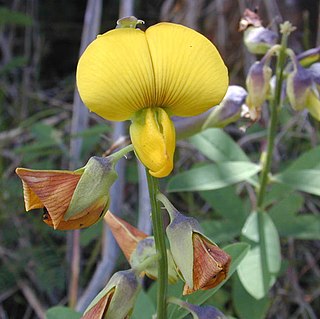
The Faboideae are a subfamily of the flowering plant family Fabaceae or Leguminosae. An acceptable alternative name for the subfamily is Papilionoideae, or Papilionaceae when this group of plants is treated as a family.

Phaseolus is a genus of herbaceous to woody annual and perennial vines in the family Fabaceae containing about 70 plant species, all native to the Americas, primarily Mesoamerica.

Cercis is a genus of about 10 species in the subfamily Cercidoideae of the pea family Fabaceae. It contains small deciduous trees or large shrubs commonly known as redbuds in the USA. They are characterised by simple, rounded to heart-shaped leaves and pinkish-red flowers borne in the early spring on bare leafless shoots, on both branches and trunk ("cauliflory"). The genus contains ten species, native to warm temperate regions of North America, southern Europe, western and central Asia, and China.

Vigna is a genus of plants in the legume family, Fabaceae, with a pantropical distribution. It includes some well-known cultivated species, including many types of beans. Some are former members of the genus Phaseolus. According to Hortus Third, Vigna differs from Phaseolus in biochemistry and pollen structure, and in details of the style and stipules.

The plant tribe Phaseoleae is one of the subdivisions of the legume subfamily Faboideae, in the unranked NPAAA clade. This group includes many of the beans cultivated for human and animal food, most importantly from the genera Glycine, Phaseolus, and Vigna.
Condylostylis is a small genus of flowering plants in the legume family, Fabaceae. It belongs to subfamily Faboideae. The genus includes four species native to the tropical Americas, ranging from southeastern Mexico to northern Argentina. Species in this genus were formerly considered to belong to the genus Vigna.
Dolichopsis is a small genus of flowering plants in the legume family, Fabaceae. It belongs to the subfamily Faboideae. It includes three species native to South America, ranging from west-central and southeastern Brazil to Bolivia, Paraguay, and northern Argentina.

Leptospron is a small genus of flowering plants in the legume family, Fabaceae. It contains two species with a pantropical distribution. It belongs to the subfamily Faboideae. Species in this genus were formerly considered to belong to the genus Vigna.

Macroptilium is a genus of flowering plants in the legume family, Fabaceae. It belongs to the subfamily Faboideae.
Mysanthus uleanus is a species of flowering plant in the legume family, Fabaceae. It is a climbing herb endemic to eastern Brazil. It grows in seasonally-dry tropical wooded grassland, thorn scrub, rocky shrubland, and in degraded areas. It is the only described member of the genus Mysanthus, though there is a report of an undescribed species. The genus belongs to subfamily Faboideae.

Sigmoidotropis is a genus of flowering plants in the legume family, Fabaceae. It includes eight species native to the tropical Americas, ranging from northern Mexico and the Caribbean islands to southern Brazil. It belongs to the subfamily Faboideae. Species in this genus were formerly considered to belong to the genus Vigna.

Strophostyles is monophyletic three-species genus of flowering plants in the family Fabaceae, subfamily Faboideae. Common names for the genus include wild bean and fuzzybean. It consists of annual and perennial herbaceous vines, ranging in their native distribution from Nevada, east to Florida, and north to the Great Lakes and eastern Canada. The etymology of the name is strophe (turning) + stylos (style), referring to the curve of the style within the keel petal.

The tribe Brongniartieae is one of the subdivisions of the plant family Fabaceae, primarily found in tropical regions of the Americas and in Australia The members of this tribe consistently form a monophyletic clade in molecular phylogenetic analyses. The tribe does not currently have a node-based definition, but morphological synapomorphies have been identified:
"stamens united by filaments in an adaxially open tube; anthers alternately long and basifixed, short and versatile; anther connective inconspicuous; septa present between seeds in pods; aril lateral lobe present and fitting into heel of funicle; fine red glandular processes present in axils; and pollen tricolporate with opercula and no definite endoaperture."

Ancistrotropis is a genus of flowering plants in the legume family, Fabaceae. It belongs to the subfamily Faboideae. Species in this genus were formerly considered to belong to the genus Vigna.
Helicotropis is a small genus of flowering plants in the legume family, Fabaceae. It belongs to the subfamily Faboideae. It includes three species of perennial climbing vines native to the tropical Americas, ranging from southern Mexico to northeastern Argentina. Species in this genus were formerly considered to belong to the genus Vigna.

Ramirezella is a small genus of flowering plants in the family Fabaceae. It includes seven species of climbing herbs native to southern North America, ranging from northern Mexico and Nicaragua. Typical habitats include seasonally-dry tropical forest and secondary vegetation in disturbed areas. It belongs to the subfamily Faboideae.

Wajira is a small genus of flowering plants in the legume family, Fabaceae. It includes five species of climbing herbs or subshrubs native to tropical Africa, the Indian subcontinent, and Thailand. Four species are native to the Somali-Masai region of northeastern tropical Africa. Wajira grahamiana is more widespread in Africa and ranges to the Indian subcontinent and Indochina. Typical habitats are seasonally-dry tropical forest, woodland, bushland, and grassland. It belongs to the subfamily Faboideae. Species in this genus were formerly considered to belong to the genus Vigna. A key for the genus has been published.

Limadendron is a genus of small trees in the family Fabaceae. It includes two species native to northern South America, including Colombia, Venezuela, the Guianas, northern Brazil, and Peru. The genus was recently separated from the genus Poecilanthe. It belongs to the tribe Brongniartieae.
Gwilym Peter Lewis is a British botanist, a curator at the Royal Botanic Gardens, Kew, and a leading expert on neotropical Leguminosae.
Phaseolus glabellus is a species of flowering plant in the genus Phaseolus. It is native to Mexico, with red flowers.














